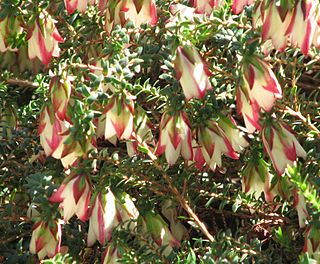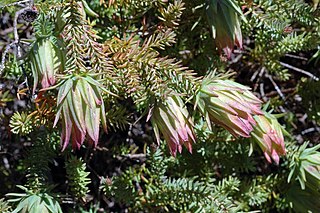
Darwinia, sometimes commonly known as mountain bells or simply bells, is a genus of about 70 species of evergreen shrubs in the family Myrtaceae, endemic to southeastern and southwestern Australia. The majority are native to southern Western Australia, but a few species occur in South Australia, New South Wales and Victoria. The genus was named in honour of Erasmus Darwin, grandfather of Charles Darwin by Edward Rudge in 1816. Most darwinias grow to a height of between 0.2 and 3 m, and many are prostrate shrubs. Most have small, simple leaves and the flowers are often grouped together, each flower with five red, white or greenish petals and ten stamens. In many species, the flowers are surrounded by large, colourful bracts, giving rise to their common names.
Banksia tortifolia is a small, spreading, prostrate shrub that is endemic to the southwest of Western Australia. It has short underground stems, pinnatipartite leaves with sharply-pointed, linear lobes on each side, greenish-cream, yellow and pink flowers in heads of about eighty, and glabrous, egg-shaped follicles.

Darwinia macrostegia, commonly known as Mondurup bell, is a species of flowering plant in the family Myrtaceae and is endemic to the south-west of Western Australia. It is a straggly shrub with elliptic leaves and clusters of pendent flowers surrounded by red and white bracts.

Darwinia citriodora, commonly known as lemon-scented darwinia or lemon scented myrtle, is a plant in the myrtle family Myrtaceae and is endemic to the south-west of Western Australia. It is a shrub with oblong to lance-shaped leaves and red, yellow and orange flowers over an extended period. It is a hardy plant in well-drained soil, is often cultivated and used as a rootstock for less hardy species.

Verticordia oculata is a flowering plant in the myrtle family, Myrtaceae and is endemic to Western Australia. It is a sprawling woody shrub with large, circular leaves with white edges and silver-white flowers with a dark centre of lilac and purple, the largest flowers of the genus Verticordia. The botanist Ferdinand von Mueller reportedly became entranced by its floral display when he visited the northern sandplains area in 1877, later describing the shrub as the 'princess of Australian flora'.
Verticordia verticordina is a flowering plant in the myrtle family, Myrtaceae and is endemic to a small area near the coast of the south-west of Western Australia. It is a small, low-growing shrub with crowded leaves and in spring, scattered pale greenish-cream and golden brown flowers. Its unusual flowers and fleshy leaves give the plant a superficial resemblance to a Darwinia.

Darwinia diosmoides is a species of flowering plant in the myrtle family Myrtaceae and is endemic to the south-west of Western Australia. It is a dense, erect shrub with linear leaves and more or less spherical heads of white flowers.

Melaleuca acutifolia is a plant in the myrtle family, Myrtaceae and is endemic to the south-west of Western Australia. It has small, pointed, oval leaves and in summer, heads of white flowers. The species was originally described as a variety of Melaleuca lateriflora but was raised to species status in 2010.

Verticordia chrysostachys is a flowering plant in the myrtle family, Myrtaceae and is endemic to the south-west of Western Australia. It is an open-branched shrub with egg-shaped to almost circular leaves, and spike-like groups of cream-coloured or deep yellow flowers.
Verticordia helmsii is a flowering plant in the myrtle family, Myrtaceae and is endemic to the south-west of Western Australia. It is a shrub with most of its leaves clustered on short side branches and with small groups of scented creamish-white flowers in small groups along the branches.

Darwinia helichrysoides is a species of flowering plant in the myrtle family Myrtaceae and is endemic to a small area in south-west of Western Australia. It is a slender shrub with linear leaves and drooping heads of about 4 red and green flowers surrounded by many glabrous bracts.

Darwinia oederoides is a species of flowering plant in the family Myrtaceae and is endemic to the south-west of Western Australia. It is a low, spreading shrub with linear leaves and clusters of pendent flowers surrounded by red and yellow bracts.

Darwinia oldfieldii is a species of flowering plant in the family Myrtaceae and is endemic to Western Australia. It is an erect, spreading shrub with oblong leaves and dense heads of erect, red flowers.

Darwinia pauciflora is a species of flowering plant in the family Myrtaceae and is endemic to the southwest of Western Australia. It is an open to bushy shrub with oblong to egg-shaped leaves and heads of erect, creamy-white and pink flowers.

Darwinia pinifolia is a species of flowering plant in the family Myrtaceae and is endemic to the southwest of Western Australia. It is a low, spreading to prostrate shrub with linear leaves and dense heads of erect, red to purple flowers.

Darwinia purpurea, commonly known as the rose darwinia, is a species of flowering plant in the family Myrtaceae and is endemic to the southwest of Western Australia. It is a spreading shrub with linear leaves and dense heads of red or yellow flowers surrounded by many overlapping involucral bracts.

Darwinia sanguinea is a species of flowering plant in the myrtle family Myrtaceae and is endemic to the south-west of Western Australia. It is a prostrate, sprawling shrub that typically grows to a height of 5–20 cm (2.0–7.9 in) and has reddish purple flowers between August and December.

Darwinia speciosa is a plant in the myrtle family Myrtaceae and is endemic to the southwest of Western Australia. It is a dwarf, spreading or prostrate shrub with narrowly oblong leaves arranged in opposite pairs, and greenish flowers surrounded by larger dark red or brownish involucral bracts.

Darwinia thymoides is a species of flowering plant in the myrtle family Myrtaceae and is endemic to the south-west of Western Australia. It is a low, spreading to prostrate shrub with linear to lance-shaped leaves and groups of 4 to 8 green, red or white flowers surrounded by leaf-like bracts.

Darwinia vestita, commonly known as pom-pom darwinia, is a species of flowering plant in the family Myrtaceae and is endemic to the southwest of Western Australia. It is an erect, bushy shrub with crowded egg-shaped, oblong, or linear leaves and more or less spherical heads of white to reddish-pink flowers.


















